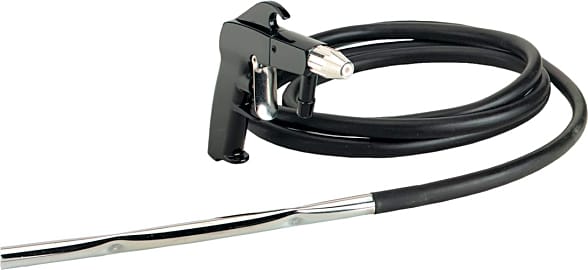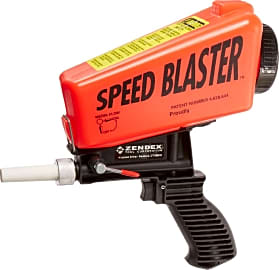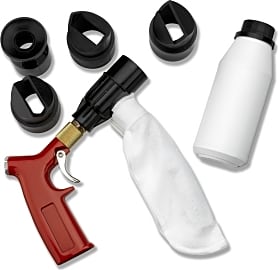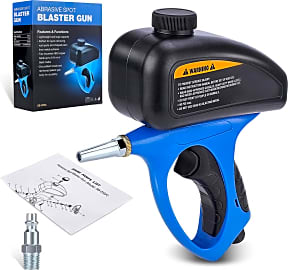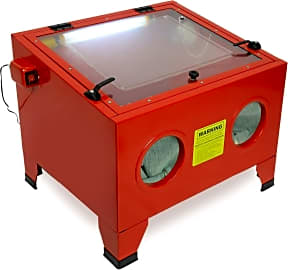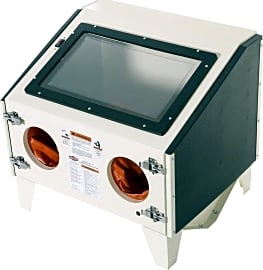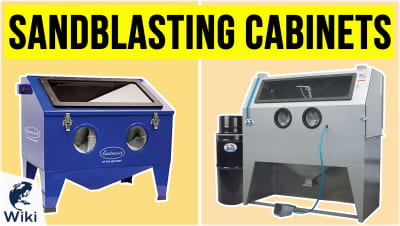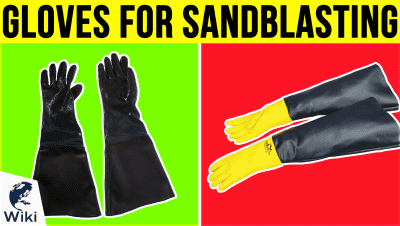The 10 Best Sandblasters

This wiki has been updated 37 times since it was first published in June of 2016. A sandblaster is the perfect tool for preparing parts for finishing with a powder coating or paint. They use abrasive mediums, like walnut shells or aluminum oxide, to remove old paint and rust quickly and effectively, and can also be used for artistic projects, like etching glass or weathering wood. Find the ideal model for your next job from our comprehensive selection. When users buy our independently chosen editorial selections, we may earn commissions to help fund the Wiki.
Editor's Notes
November 18, 2020:
For this update, we removed the XtremepowerUS 61200, Performance Tool M549, and Dragway Tools Model 60, due to quality issues and concerns about their durability.
We also removed the OEMTools 24815, and replaced it with the AJ Tools CHIM0061, a more reliable cabinet model. The great thing about cabinet sandblasters is that they contain the blast media in one area, which makes for a much cleaner, and safer work environment. Their smaller size makes them unsuitable for larger objects, but if you only plan on working on smaller items, like removing rust from engine parts, or etching glass, they’d be a great choice. Here's a collection of sandblasting cabinets if you're interested in seeing more of a variety.
Whether you're able to use a cabinet or not, it's important to always follow the correct safety protocols when using a sandblaster. Combining high-pressure air and projectiles is inherently a dangerous situation, so always remain focused on the task at hand and be aware of your surroundings. Make sure to also inspect your equipment for any holes, leaks, or other damage before you begin. During operation, make sure to wear appropriate sandblasting gloves, eye protection, and a respirator.
July 04, 2019:
Your blasting needs should dictate what model is best for you. If you will be working on small parts and want to keep your media contained, whether simply to not make a mess or because you want to reuse it later, an enclosed cabinet will be a good option. Of the three cabinets on our list, the Dragway Tools Model 60 is the only floor-standing unit. The OEMTools 24815 and Shop Fox M1114 are both benchtop models. All three are equipped with lights inside the cabinet, but the Dragway Tools Model 60 is the only one that comes with an LED. The other two have fluorescent bulbs, which are a bit dimmer.
If you need to remove rust or paint from larger surfaces, a cabinet won't be suitable. In this case, we recommend models like the Lematec Portable AS118, Performance Tool M549, Black Bull SFSB90, Campbell Hausfeld AT122601AV, Zendex SpeedBlaster, and XtremepowerUS 61200. Of these, the Lematec Portable AS118 and Zendex SpeedBlaster are probably the most convenient. They feature an abrasive reservoir attached to the gun, so you won't have to worry about lugging around both a compressor and a large tank. Of course, since the hoppers are attached to the gun, they are quite small, making these two models best for smaller jobs. For larger jobs, the Black Bull SFSB90 and XtremepowerUS 61200 are ideal, featuring a 7.5- and 10-gallon tank, respectively. If you need to sandblast small spots on a large surface or piece of equipment and can't take the chance on media hitting the surrounding areas, consider the Neiko 30042 Spot Shot, which comes with nozzles specifically-designed for getting at hard to reach edges and corners.
Special Honors
Grizzly G0707 Large enough to handle most needs, but not so big that it completely takes over a shop, this blast cabinet is a good choice for commercial facilities that need to remove rust, paint, and scale from a lot of equipment every day. It features a well-placed control panel that lets you check the pressure or adjust the material flow without taking too much of your time and attention away from the job at hand. grizzly.com
Skat Blast 1936 Double Duty This commercial unit comes fully assembled, perfectly sealed, and ready to use. As the name suggests, it allows for two people to work side by side, and it offers enough space to accommodate large automotive and industrial parts that would normally have to be blasted outside. skatblast.com
Compression And Abrasion At Its Finest
Three main types of sandblasters include gravity-fed, siphon, and pressure models.
If you're planning to renovate your home, prepare a component for a new coat of paint, or clean the rust and corrosion away from your tools, then a sandblaster is the perfect abrasive solution.
A sandblaster is a compressed air tool designed to propel pressurized silica sand, or some other type of granulated abrasive, toward the surface of various objects. This is done at a high velocity in order to grind surfaces down to a smooth finish or to clear away debris, rust, and other contaminants that have formed on the surfaces over time. Depending on its design and operation, the sandblaster consists of an air-powered pressure gun connected to a hose and air compressor, as well as some type of hopper or container from which the gun draws its abrasive. The gun's barrel is usually made out of ceramic with an internal coating to prevent the abrasive from eroding it through extended use.
Three main types of sandblasters include gravity-fed, siphon, and pressure models. A gravity-fed sandblaster consists of a handheld pressure gun connected to an air compressor (or pressurized air tank) by means of a hose. It is usually equipped with an abrasive hopper mounted directly above its gun. When the gun's trigger is depressed and held down continuously, compressed air rapidly flows through and out of the gun's nozzle. At the same time, a slot at the top of the gun, into which the hopper is inserted, opens to allow both the high velocity of air and gravity to pull the sand from the hopper down in to the gun and out of the gun's barrel.
By contrast, the siphon sandblaster is equipped with two separately dedicated hoses, one connected to the bottom of the gun's handle and the other attached directly to the underside of the gun barrel. When the trigger is pulled, compressed air creates suction, drawing the abrasive media up to the gun barrel where it is fired. Unlike the gravity-fed model, the siphon blaster's reservoir is located below its gun nozzle, hence the use of suction to draw up the abrasive.
Less common for domestic applications, and operating in a similar manner to that of an aerosol can, the pressure sandblaster includes a large and enclosed canister of silica sand under high pressure. Its gun connects to a port at the top of the canister by means of a specialized hose. When the trigger is pulled, both pressurized air and sand are forced through the hose and out of the gun. Although this minimizes cleanup time for a professional crew, the sand cannot be collected and reused. Additionally, the pressure blaster's canister must be replaced when empty, making it a less cost-effective solution for the DIY consumer.
Maintaining Control, Convenience, and Versatility
The type of sandblaster one chooses to invest in depends on the location and requirements of the job, so it's important to choose wisely. For example, if you anticipate sandblasting surfaces in tight corners and hard-to-reach places around your home, then a siphon sandblaster is a good solution. There won't be a bulky container above the gun to get in your way while you work. Also, consider the hose length of the blaster to ensure you have enough room to keep the container up to 10 or more feet away from your workspace when you happen to be sandblasting those same corners and tight spots.
An ideal pressure range for a handheld gravity-fed unit is between 90 and 120 pounds per square inch.
Consider the type of air compressor you choose to use in conjunction with the device. While there is no need to invest in an industrial-grade unit with a large abrasive tank for projects in a small home, awareness of the blaster's air power is important to ensure you get enough force and pressure to maximize results quickly, while minimizing the need for unnecessary cleanup time. An ideal pressure range for a handheld gravity-fed unit is between 90 and 120 pounds per square inch.
If you're working in a variety of locations with different materials, then a sandblaster with an integrated media control valve comes in handy, as you'll be able to adjust the flow of your blast media depending on the situation. It's also important to be aware of the tool's versatility for accepting a variety of abrasives, regardless of the model type. Many sandblasters are capable of accepting silicon carbide, glass, and crushed nutshells among other media.
Safety is a major consideration when working around potentially harmful airborne contaminants, as well. If constant use of a sandblaster is part of your trade, then minimize the risk of unhealthy exposure to your blast media by outfitting yourself with protective clothing and other equipment, such as a respirator.
A Brief History Of Sandblasters
Having seen the effects of wind-blown sand and corrosion on both windows and rocks while serving in the army, soldier and inventor Benjamin Chew Tilghman used this knowledge as his inspiration for inventing and patenting the first sandblasting machine in 1870. Tilghman used quartz within sand as his corrosive element of choice for the machine along with a jet of steam, air, and water. This represented the earliest testing phase of the new technology.
This represented the earliest testing phase of the new technology.
In 1904, Thomas Pangborn took Tilghman’s invention even further by incorporating compressed air with blast media for the purpose of cleaning metal. This helped to form the foundation for the Pangborn Corporation, which still manufactures and supplies sandblasting machines internationally to this day.
New types of blast media were identified by the late 1930s as a response to a growing concern over high-risk exposure to silica dust and potentially fatal silicosis. Since that time, sandblaster versatility, safety, and durability have been refined to accommodate a variety of job types for both domestic and professional use.



